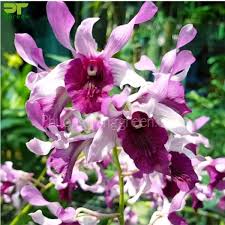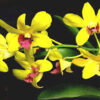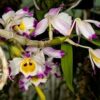# Detecting and Managing Fungal Diseases on Dendrobium Orchids: A Comprehensive Guide

Dendrobium orchids, renowned for their stunning flowers and diverse varieties, can occasionally fall victim to fungal diseases, which can threaten their health and beauty. Proper identification and management of these diseases are crucial for maintaining healthy plants. This comprehensive guide will explore how to detect fungal diseases on Dendrobium orchids, the various types of fungal infections they may encounter, and effective management strategies to ensure your orchids thrive.
## Table of Contents
1. **Understanding Fungal Diseases**
– 1.1 What Are Fungal Diseases?
– 1.2 Importance of Early Detection
2. **Common Fungal Diseases in Dendrobium Orchids**
– 2.1 Root Rot
– 2.2 Leaf Spot
– 2.3 Powdery Mildew
– 2.4 Gray Mold (Botrytis)
– 2.5 Anthracnose
3. **Identifying Fungal Diseases**
– 3.1 Symptoms of Root Rot
– 3.2 Recognizing Leaf Spot
– 3.3 Identifying Powdery Mildew
– 3.4 Detecting Gray Mold
– 3.5 Spotting Anthracnose
4. **Factors Contributing to Fungal Infections**
– 4.1 Environmental Conditions
– 4.2 Improper Watering Practices
– 4.3 Poor Air Circulation
– 4.4 Infected Tools and Equipment
5. **Management and Treatment of Fungal Diseases**
– 5.1 General Management Strategies
– 5.2 Specific Treatments for Each Disease
– 5.3 Preventive Measures
6. **Best Practices for Orchid Care**
– 6.1 Proper Watering Techniques
– 6.2 Maintaining Humidity Levels
– 6.3 Ensuring Adequate Air Circulation
– 6.4 Regular Inspection and Maintenance
7. **Conclusion**
– 7.1 Recap of Key Points
– 7.2 Final Thoughts on Fungal Disease Management
—
## 1. Understanding Fungal Diseases
### 1.1 What Are Fungal Diseases?
Fungal diseases are infections caused by various types of fungi that can affect plants, including orchids. Fungi thrive in warm, moist environments and can attack different parts of the plant, leading to various symptoms such as discoloration, wilting, and decay.
### 1.2 Importance of Early Detection
Early detection of fungal diseases is crucial for effective management. Identifying symptoms early can prevent the spread of the infection and minimize damage to your Dendrobium orchids. Understanding the specific diseases that can affect your plants will empower you to take the necessary steps to maintain their health.
## 2. Common Fungal Diseases in Dendrobium Orchids
### 2.1 Root Rot
Root rot is one of the most common fungal diseases affecting Dendrobium orchids. It occurs when the roots are exposed to excessive moisture, often due to overwatering or poorly draining potting media.
– **Symptoms**: Roots become brown, mushy, and may emit a foul odor. Affected plants may display yellowing leaves and stunted growth.
### 2.2 Leaf Spot
Leaf spot diseases are caused by various fungi and can manifest as dark, water-soaked lesions on the leaves.
– **Symptoms**: The spots can vary in color from brown to black, and as the disease progresses, the leaf tissue surrounding the spots may turn yellow and die.
### 2.3 Powdery Mildew
Powdery mildew is a fungal disease characterized by a white, powdery coating on leaves and stems.
– **Symptoms**: This disease thrives in high humidity and poor air circulation, leading to stunted growth and leaf drop.
### 2.4 Gray Mold (Botrytis)
Gray mold is caused by the Botrytis cinerea fungus and typically affects flowers, buds, and leaves.
– **Symptoms**: Affected areas appear water-soaked and develop gray, fuzzy mold, especially in damp conditions.
### 2.5 Anthracnose
Anthracnose is a fungal disease that can affect leaves, stems, and flowers.
– **Symptoms**: It presents as dark, sunken lesions that can spread rapidly, leading to significant damage if not managed promptly.
## 3. Identifying Fungal Diseases
### 3.1 Symptoms of Root Rot
– **Signs**: Brown, mushy roots; yellowing leaves; stunted growth; and a foul smell from the potting mix.
– **Identification**: Remove the orchid from the pot to inspect the roots. Healthy roots should be firm and white or green.
### 3.2 Recognizing Leaf Spot
– **Signs**: Dark lesions on leaves, often with yellow halos.
– **Identification**: Check the underside of leaves for signs of fungal spores or webbing.
### 3.3 Identifying Powdery Mildew
– **Signs**: White, powdery spots on leaves and stems.
– **Identification**: Gently wipe the leaves; if the powder comes off easily, it’s likely powdery mildew.
### 3.4 Detecting Gray Mold
– **Signs**: Water-soaked areas followed by fuzzy gray mold.
– **Identification**: Look for moldy spots on flowers, buds, and leaves, particularly in high humidity.
### 3.5 Spotting Anthracnose
– **Signs**: Dark, sunken lesions with a possibility of yellowing around the edges.
– **Identification**: Check for rapid spread of lesions on leaves and stems, particularly in wet conditions.
## 4. Factors Contributing to Fungal Infections
Understanding the conditions that contribute to fungal infections can help you take preventive measures.
### 4.1 Environmental Conditions
Fungal infections are more prevalent in warm, humid environments. Maintaining optimal humidity levels (around 40-60%) is essential for orchid health.
### 4.2 Improper Watering Practices
Overwatering or allowing the potting mix to remain soggy can create conditions favorable for fungal growth. Always ensure that the potting medium drains well.
### 4.3 Poor Air Circulation
Inadequate air circulation around your Dendrobium orchids can lead to stagnant air, increasing humidity levels and promoting fungal infections. Good air movement helps reduce humidity and prevents mold growth.
### 4.4 Infected Tools and Equipment
Using contaminated tools or pots can introduce fungal spores to healthy plants. Always sterilize tools and equipment before use.
## 5. Management and Treatment of Fungal Diseases
### 5.1 General Management Strategies
Effective management of fungal diseases involves a combination of cultural practices and treatments.
– **Quarantine**: Isolate infected plants to prevent the spread of the disease.
– **Cleanliness**: Regularly clean the growing area, pots, and tools to minimize fungal spores.
– **Air Circulation**: Use fans or open windows to improve air circulation.
### 5.2 Specific Treatments for Each Disease
#### Root Rot
– **Treatment**: Remove the orchid from the pot, trim away affected roots, and repot in fresh, well-draining potting mix. Allow the roots to dry out before watering.
#### Leaf Spot
– **Treatment**: Prune affected leaves to prevent further spread. Apply a fungicide labeled for orchids, following the manufacturer’s instructions.
#### Powdery Mildew
– **Treatment**: Increase air circulation and reduce humidity. Spray affected areas with a mixture of water and baking soda (1 tablespoon of baking soda per gallon of water) to inhibit fungal growth.
#### Gray Mold
– **Treatment**: Remove infected flowers and improve air circulation. Use a fungicide if the problem persists.
#### Anthracnose
– **Treatment**: Prune affected areas and improve drainage. Apply a fungicide labeled for anthracnose.
### 5.3 Preventive Measures
Preventing fungal infections is often easier than treating them. Consider the following preventive strategies:
– **Proper Watering**: Water in the morning to allow time for foliage to dry during the day.
– **Routine Inspections**: Regularly check for early signs of disease and address issues promptly.
– **Use of Sterilized Media**: Always use fresh, sterilized potting media to minimize the risk of fungal spores.
## 6. Best Practices for Orchid Care
In addition to managing fungal diseases, incorporating best practices into your orchid care routine will promote healthy growth and reduce the risk of infections.
### 6.1 Proper Watering Techniques
– Water your Dendrobium orchids when the potting mix feels dry to the touch, ensuring that excess water drains out of the pot.
– Avoid letting the pot sit in standing water, as this can lead to root rot.
### 6.2 Maintaining Humidity Levels
– Keep humidity levels around 40-60% by using humidity trays or misting the plants.
– Use a hygrometer to monitor humidity levels in your growing environment.
### 6.3 Ensuring Adequate Air Circulation
– Position fans to create gentle airflow around your orchids.
– Avoid crowding plants together to allow for better air movement.
### 6.4 Regular Inspection and Maintenance
– Inspect your orchids regularly for signs of disease or pests.
– Remove dead or yellowing leaves to prevent fungal spores from spreading.
## 7. Conclusion
### 7.1 Recap of Key Points
Fungal diseases can pose a significant threat to Dendrobium orchids, but with proper identification and management strategies, you can protect your plants. Understanding the common fungal diseases, their symptoms, and the conditions that promote their growth is essential for effective treatment.
### 7.2 Final Thoughts on Fungal Disease Management
By implementing preventive measures
, maintaining optimal care practices, and addressing issues promptly, you can enjoy beautiful, healthy Dendrobium orchids for years to come. Stay vigilant, and remember that early detection is key to managing fungal diseases successfully. Happy gardening!

